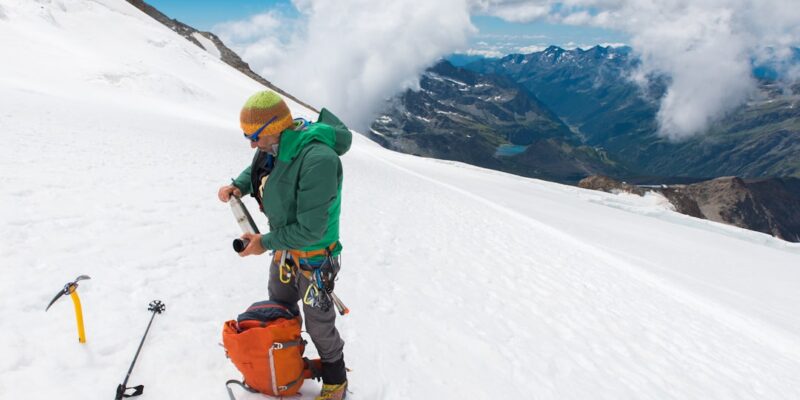
Ice Climbing: Techniques and Safety Tips
Ice climbing is a thrilling and challenging adventure sport that involves ascending frozen waterfalls, ice formations, and glaciers using specialized equipment and techniques. It is a subset of mountaineering and rock climbing, but with its own unique set of challenges and risks. Ice climbing requires strength, endurance, mental focus, and technical skills to navigate the icy terrain.
The origins of ice climbing can be traced back to the early 20th century when mountaineers began exploring frozen waterfalls and ice formations as a way to challenge themselves and push the boundaries of their sport. Over the years, ice climbing has evolved into a popular activity for outdoor enthusiasts and has even become a competitive sport with its own competitions and events.
People engage in ice climbing for various reasons. For some, it is the thrill of conquering a frozen waterfall or scaling an icy peak that attracts them to the sport. The physical and mental challenges of ice climbing provide a sense of accomplishment and personal growth. Others are drawn to the beauty and serenity of the frozen landscapes, finding solace in the quiet solitude of the mountains. Ice climbing also offers a unique opportunity to connect with nature and experience the raw power and beauty of winter environments.
Key Takeaways
- Ice climbing is a challenging adventure sport that requires specialized gear and techniques.
- Essential gear for ice climbing includes crampons, ice axes, helmets, and ropes.
- Proper footwork, tool placement, and body positioning are crucial for successful ice climbing.
- Climbing on different types of ice presents unique challenges and requires different techniques.
- Safety is paramount in ice climbing, and climbers must assess risks, manage hazards, and avoid accidents.
Essential Gear and Equipment for Ice Climbing
Ice climbing requires specialized gear and equipment to ensure safety and efficiency on the ice. Here are some of the essential items needed for ice climbing:
1. Ice climbing boots: These boots are specifically designed for ice climbing and have stiff soles for better stability on the ice. They also have insulation to keep feet warm in cold temperatures.
2. Crampons: Crampons are metal spikes that attach to the bottom of boots to provide traction on icy surfaces. They come in different styles depending on the type of ice climbing being done.
3. Ice axes: Ice axes are used for both balance and self-arrest in case of a fall. They have a curved pick on one end for gripping the ice and a spike on the other end for stability.
4. Harness: A climbing harness is worn around the waist and legs to attach oneself to the rope and provide support during climbs. It is important to choose a harness that is comfortable and fits properly.
5. Helmet: A helmet is essential for protecting the head from falling ice or rock debris. It should fit snugly and have adjustable straps for a secure fit.
6. Ropes: Climbing ropes are used to secure climbers to their partners and provide protection in case of a fall. Dynamic ropes are recommended for ice climbing as they have some stretch to absorb the impact of a fall.
7. Clothing and accessories: Layered clothing is essential for ice climbing to regulate body temperature. Base layers should be moisture-wicking, insulating layers should provide warmth, and outer layers should be waterproof and windproof. Other accessories include gloves, goggles, and gaiters to protect against cold and wet conditions.
Understanding Ice Climbing Techniques: Footwork, Tool Placement, and Body Positioning
Proper technique is crucial in ice climbing to ensure efficiency, safety, and success on the ice. Here are some key techniques used in ice climbing:
1. Footwork techniques: Good footwork is essential for maintaining balance and stability on the ice. Techniques such as front-pointing (using the front points of crampons) and flat-footing (using the entire sole of the boot) are used depending on the terrain and conditions.
2. Tool placement techniques: Proper tool placement is important for secure holds on the ice. Tools should be swung with precision and accuracy to ensure they penetrate the ice effectively. Techniques such as hooking (using the pick to hook onto features in the ice) and torquing (twisting the tool to create a secure hold) are used.
3. Body positioning techniques: Body positioning plays a crucial role in ice climbing. Proper body alignment and balance are important for efficient movement and weight distribution. Techniques such as flagging (using one leg to counterbalance the body) and stemming (using both feet to create stability) are used to maintain balance and conserve energy.
Climbing on Different Types of Ice: Understanding the Differences and Challenges
| Type of Ice | Difficulty Level | Challenges |
|---|---|---|
| Glacier Ice | Intermediate | Crevasse danger, unpredictable ice conditions |
| Alpine Ice | Advanced | Steep terrain, thin ice, rockfall hazard |
| Waterfall Ice | Expert | Vertical ice, fragile ice, difficult protection |
| Sea Ice | Beginner | Unpredictable ice conditions, cold temperatures |
Ice formations come in various types, each with its own unique characteristics and challenges. Understanding the differences between these types of ice is important for successful climbing. Here are some common types of ice formations encountered in ice climbing:
1. Water ice: Water ice is formed by freezing water and is the most common type of ice encountered in ice climbing. It can range from thin, delicate ice to thick, solid ice. Climbing on water ice requires good tool placement and technique to ensure secure holds.
2. Alpine ice: Alpine ice refers to ice formations found in high-altitude mountain environments. It is often found on glaciers and can be challenging due to its variable nature and exposure to the elements. Climbing on alpine ice requires careful route finding and navigation skills.
3. Mixed ice: Mixed ice refers to a combination of rock and ice, where climbers use their tools and crampons on both surfaces. It requires a different set of techniques and skills compared to pure ice climbing, as climbers need to be proficient in both rock climbing and ice climbing techniques.
Each type of ice presents its own set of challenges. Thin, delicate ice requires delicate footwork and tool placement, while thick, solid ice requires more power and strength. Climbing on alpine ice requires good route finding skills and the ability to navigate complex terrain. Mixed climbing requires a combination of rock climbing and ice climbing techniques, as well as the ability to adapt to changing conditions.
Safety Tips for Ice Climbing: Assessing Risks, Managing Hazards, and Avoiding Accidents
Ice climbing can be a dangerous sport, and it is important to prioritize safety at all times. Here are some safety tips to consider when ice climbing:
1. Risk assessment: Before starting a climb, assess the risks involved, including the condition of the ice, weather conditions, and avalanche hazards. Be aware of your own abilities and limitations and make informed decisions based on the conditions.
2. Hazard management: Identify potential hazards such as falling ice, rockfall, or unstable snow and take appropriate measures to manage them. Use helmets and other protective gear to minimize the risk of injury from falling debris.
3. Accident prevention: Practice good climbing techniques and use proper equipment to minimize the risk of accidents. Be mindful of your surroundings and communicate with your climbing partners to ensure everyone is on the same page.
4. Emergency response: Have a plan in place for emergencies and know how to respond in case of an accident or injury. Carry a first aid kit and know how to administer basic first aid. Have a communication device such as a satellite phone or radio to call for help if needed.
Preparing for an Ice Climbing Expedition: Training, Planning, and Logistics
Preparing for an ice climbing expedition requires physical training, mental preparation, and careful planning. Here are some tips to help you prepare for your ice climbing adventure:
1. Physical training: Ice climbing requires strength, endurance, and flexibility. Incorporate activities such as hiking, running, weightlifting, and yoga into your training routine to build strength and improve overall fitness. Focus on exercises that target the muscles used in ice climbing, such as the core, arms, and legs.
2. Mental preparation: Ice climbing can be mentally challenging, especially when faced with difficult or exposed terrain. Practice mental exercises such as visualization and positive self-talk to build mental resilience and confidence. Develop problem-solving skills and learn to stay calm and focused in stressful situations.
3. Planning and logistics: Plan your ice climbing expedition carefully, taking into consideration factors such as weather conditions, route selection, and equipment needs. Research the area you will be climbing in and familiarize yourself with the local regulations and guidelines. Make sure you have all the necessary permits and permissions.
Climbing in Extreme Cold: Dealing with Hypothermia, Frostbite, and Other Health Risks
Climbing in extreme cold temperatures presents additional health risks that need to be managed. Here are some health risks associated with extreme cold and how to deal with them:
1. Hypothermia: Hypothermia occurs when the body loses heat faster than it can produce it, resulting in a dangerously low body temperature. Symptoms include shivering, confusion, fatigue, and loss of coordination. To prevent hypothermia, dress in layers to regulate body temperature, stay hydrated, and take regular breaks to warm up. If someone shows signs of hypothermia, get them to a warm shelter and seek medical help immediately.
2. Frostbite: Frostbite occurs when the skin and underlying tissues freeze due to prolonged exposure to cold temperatures. It most commonly affects extremities such as fingers, toes, ears, and nose. To prevent frostbite, dress warmly and protect exposed skin with appropriate clothing and accessories. If frostbite occurs, rewarm the affected area gradually using warm water or body heat. Seek medical help if necessary.
3. Other health risks: Other health risks associated with extreme cold include dehydration, sunburn (due to reflection off the snow), and altitude sickness (if climbing at high altitudes). Stay hydrated by drinking plenty of fluids, use sunscreen to protect against sunburn, and acclimatize properly if climbing at high altitudes.
Rescue Techniques for Ice Climbing: Emergency Response, Communication, and Evacuation
In the event of an accident or emergency, it is important to know how to respond and communicate effectively. Here are some rescue techniques for ice climbing:
1. Emergency response procedures: In the event of an accident or injury, assess the situation and provide immediate first aid if necessary. Call for help using a communication device or send someone to get help if possible. Stay with the injured person and keep them warm until help arrives.
2. Communication techniques: Effective communication is crucial in rescue situations. Use clear and concise verbal commands to communicate with your climbing partners. Establish a communication plan before starting the climb and agree on signals and gestures to use in case of an emergency.
3. Evacuation procedures: If an evacuation is necessary, assess the safest and most efficient way to get the injured person to safety. This may involve lowering them down using ropes, building a makeshift stretcher, or calling for professional rescue services. Follow established evacuation procedures and prioritize the safety of everyone involved.
Environmental Considerations in Ice Climbing: Protecting the Natural Habitat and Minimizing Impact
Ice climbing can have an impact on the natural environment, and it is important to minimize this impact and practice responsible climbing. Here are some ways to protect the natural habitat while ice climbing:
1. Environmental impact of ice climbing: Ice climbing can cause damage to fragile ice formations and disturb wildlife habitats. Climbers should be mindful of their actions and avoid damaging the ice or disturbing wildlife.
2. Ways to minimize impact: Minimize your impact by sticking to established trails and routes, avoiding trampling vegetation, and not disturbing wildlife. Do not leave any trace of your presence by packing out all trash and waste.
3. Responsible ice climbing practices: Practice responsible climbing by following local regulations and guidelines, respecting private property, and being considerate of other climbers. Educate yourself about the local environment and wildlife, and adjust your behavior accordingly.
Advanced Ice Climbing Techniques: Mixed Climbing, Dry Tooling, and Other Specializations
For those looking to take their ice climbing skills to the next level, there are advanced techniques and specializations to explore. Here are some examples:
1. Mixed climbing techniques: Mixed climbing involves using ice tools and crampons on both ice and rock surfaces. It requires a combination of ice climbing and rock climbing techniques, as well as the ability to adapt to changing conditions. Techniques such as dry tooling (using ice tools on rock surfaces) and hooking (using the pick to hook onto features in the rock) are used.
2. Dry tooling techniques: Dry tooling is a specialized form of mixed climbing that involves using ice tools on dry rock surfaces. It requires precise tool placement and technique to create secure holds on the rock. Dry tooling is often practiced in areas where there is no ice or during the off-season.
3. Other specialized ice climbing techniques: There are various other specialized techniques and disciplines within ice climbing, such as speed climbing (racing up a route as fast as possible), competition climbing (participating in ice climbing competitions), and big wall ice climbing (ascending large, multi-pitch ice formations). Each of these disciplines requires specific skills and training.
Ice climbing is a challenging and exhilarating adventure sport that offers a unique opportunity to explore frozen landscapes and push personal limits. With the right gear, proper technique, and a focus on safety, ice climbing can be a rewarding and fulfilling experience. Whether you are a beginner or an experienced climber, there is always something new to learn and discover in the world of ice climbing. So grab your gear, find a frozen waterfall or ice formation, and embark on your own icy adventure.
FAQs
What is ice climbing?
Ice climbing is a sport that involves ascending ice formations such as frozen waterfalls, icefalls, and cliffs using specialized equipment such as ice axes, crampons, and ropes.
What are the basic techniques of ice climbing?
The basic techniques of ice climbing include using proper footwork, maintaining balance, using ice axes and crampons, and using efficient body positioning.
What are the safety precautions for ice climbing?
Safety precautions for ice climbing include wearing appropriate clothing and gear, using proper equipment, checking the weather conditions, assessing the ice quality, and having a partner or team for support.
What are the risks associated with ice climbing?
The risks associated with ice climbing include falling, hypothermia, frostbite, avalanches, and equipment failure.
What are the different types of ice climbing?
The different types of ice climbing include waterfall ice climbing, mixed climbing, and alpine ice climbing.
What is the difference between waterfall ice climbing and mixed climbing?
Waterfall ice climbing involves climbing frozen waterfalls and ice formations, while mixed climbing involves climbing a combination of ice and rock.
What is the difference between alpine ice climbing and other types of ice climbing?
Alpine ice climbing involves climbing ice formations in high-altitude mountain environments, which requires additional skills and equipment compared to other types of ice climbing.


















